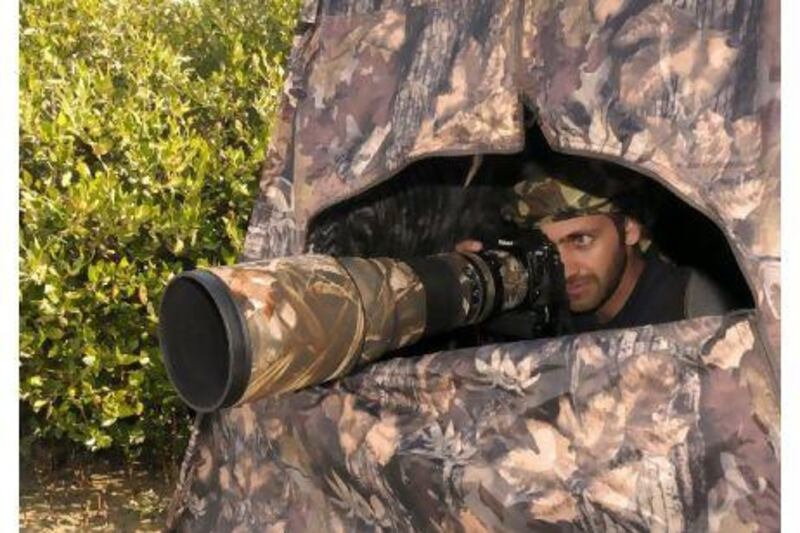While trying to explain his interest in birds and wildlife photography to sceptics, Ahmed Al Ali often asks them to guess the number of bird species living in or visiting the UAE.
They usually say 10 or 20. But the correct answer, he says, is 443.
"This is all because you don't see," said the 30-year-old UAE national from Sharjah. "You skip, you do not pay attention. If you pay attention you will see."
Mr Al Ali, an IT professional at a Government department in Abu Dhabi, is one of few Emiratis who has taken to observing and photographing birds. His hobby has changed him, and is influencing his community.
A precise, eloquent man, Mr Al Ali is aware of the value of explaining the natural world with facts. But his strongest weapon is his photography.
"I take pictures of birds in all situations - morning and evening, while they are eating, showering, dusting, fighting," he said.
While making the case for the need to preserve bird habitats, he shows people beautiful pictures of the amazing array of rare resident and visiting birds. This can get them emotionally involved, he said.
"This is the key to interest local people," he said. "After all, the same thing happened to me. After five years of photography, I find myself slipping more into wildlife and conservation."
It was the beauty of the birds that drew Mr Al Ali's interest in them as photography subjects. Before he took up photography, he was drawing - and horses were his favourite subject.
In 2005, he started practising photography, learning from online forums where photographers from other Gulf countries would post their work and offer advice to each other. It was in early 2007, after seeing the work of a Kuwaiti photographer, that he decided to make birds his subjects.
"The start was with obvious birds you can see everywhere," he said, naming his first subjects - the house sparrow, the common mynah and the parakeet. "Then I started to read and read and I discovered there is this thing called bird watching."
He got in touch with members of the Emirates Bird Records Committee. Through reading and interacting with the group, he started to learn the names of different bird species and the best locations where they could be observed. The new hobby took favour over his other interests such as amateur radio, now only done while he is driving, and video games, which he has stopped playing.
"Whenever I find time, I either read about birds or I go to look for birds," said Mr Al Ali, who recently became the UAE regional representative of the Ornithological Society of the Middle East.
He recently lectured at Kalba, showing a small but interested group of attendees what the rare birds inhabiting the town's unique mangrove forest and beaches look like.
As he discussed his hobby, he was interrupted by a telephone call from Abdulla Al Zaabi in Kalba, asking for the phone number of environmental officials. Mr Al Zaabi had noticed men trapping seagulls, most likely with the aim of selling them to falconers, and wanted to report it to authorities.
However, when the two men had first met, Mr Al Zaabi was less aware of these issues, and could not believe anyone would want to hire a fishing boat just to watch sea birds.
What helped Mr Al Ali advance as a photographer was reading about birds, interacting with bird watchers, and practice.
"When you try something for a little bit of time, you get used to it," he said.
Also important is attention to detail and patience, which, he said, "is the prime thing in wildlife photography because you are photographing a moving thing".
It took several months for him to photograph the Collared Kingfisher in Kalba's mangrove. The bird is shy and quiet, and it takes a long time to find it among the dense branches of mangroves.
The masked shrike, a small, shy migrant that visits briefly in spring, is another example.
"It took me two or three years to find this bird and I only got one decent picture," he said.
Because of the novelty of his hobby, Mr Al Ali has also seen his share of uncomfortable situations. His large lens sometimes makes people suspicious about his intentions. He has been followed by curious onlookers, which scares away the birds he is looking to photograph. Occasionally, he is stopped by village elders and police.
Yet, the enjoyment he gets from producing a beautiful picture is worth it, he said. And so is the effort to educate others on the need to preserve the country's natural heritage.
"If I was aware of this issue before going to college, I would have studied environmental science," he said. "Our education did not give us the chance to see the environment."
He said more work needs to be done to raise awareness of environmental issues.
"As they say, no one is bad. There are just people who do not know better."





